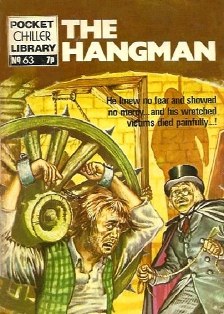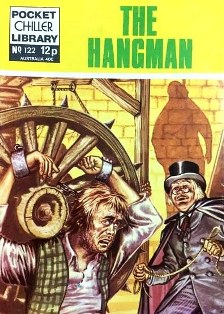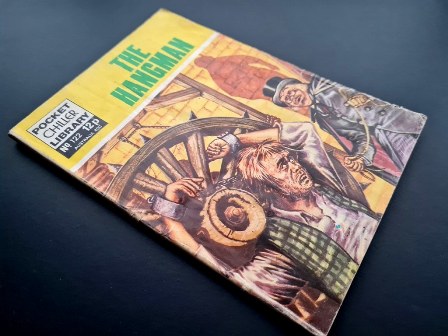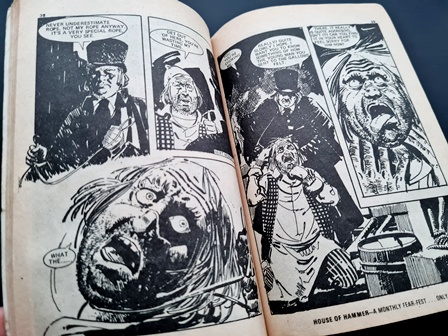
Originally Published In Issue 63

Reprinted In Issue 122
First published back in August of 1973, Issue 63 of the ‘Pocket Chiller Library’ comic series was titled ‘The Hangman’. The comic was later reprinted under the same title within Issue 122.
DLS Synopsis:
There were four crimes for which the death sentence was still maintained within England during the 1870s. Unfortunately for this young lad, he’d been found guilty of one such crime. Despite his pleads of innocence, the boy would hang. That was the law and the penalty it demanded. The sentence to death had been passed by the judge. The young lad’s life was now in the hands of London’s public hangman.
DLS Review:
This is a great little grim crime and punishment story. It’s set in the 1870s, when there were a few remaining public executions for a handful of crimes. Such executions required a hangman, for which it is believed these hangmen would often take great pride in their work.

During the 1970s the ‘Pocket Chiller Library’ was a pocket-sized mainstream horror comic which ran for a total of 137 issues between 1971 and 1977. Each month, two issues of the comic were published, amounting to a total of twenty-four issues of the comic published each year.
However, it should be noted that issue 83 and then from issue 86 onwards, the publishers started reprinting the earlier stories. Of these reprints, the first 29 reprints (issues 83 and then 86 – 113) retitled the story. As such, there were only ever a total of 84 unique stories within the series, despite there being more titles.
Unfortunately, each issue was undated, making it difficult to be sure of the date for first publication of each issue. However, it is widely understood the comics were monthly publications, with two publications released simultaneously each month, with the original stories running from January 1971. Therefore, the above date of publication is a relatively reasonable assumption.
Additionally, each issue was unfortunately uncredited to either the writer or the comic artist(s).
There were four crimes for which the death sentence was still maintained within England during the 1870s. Unfortunately for this young lad, he’d been found guilty of one such crime. Despite his pleads of innocence, the boy would hang. That was the law and the penalty it demanded. The sentence to death had been passed by the judge. The young lad’s life was now in the hands of London’s public hangman.
Osgood Thaxter kept a modest antique business which his daughter, Melanie, helped to run. However, when a message arrives by special messenger, Thaxter knows he must answer the call of duty. This was his responsibility. His role. But he kept it from his wife and daughter. He should not trouble them with the moral difficulties such a duty brings.
Thaxter understood that some had issues with the morality of a hangman. A profession dealing exclusively with enacting death. But for Osgood Thaxter he saw the job differently. He was not the executioner, he was not the one who sentenced the condemned to death, he was not responsible nor accountable, but he was merely a professional who offered a specialist service. A task which he had perfected through years of commitment. His hobby with collecting artefacts of capital punishment had led Osgood to become an expert in the field. In fact, Osgood prided himself on the trouble he took to ensure a good, swift hanging. It was his duty.
Although, this time there was something different about it all. This time something had gone wrong. Osgood had made all his usual calculations, checked and double-checked all of the equipment. But on the day of the execution, it had all gone wrong, and the boy had choked to death slowly as he was agonisingly strangled.
The guilt of the boy’s excruciating death weighed heavy on Thaxter. He started seeing visions of the young man, crying out his innocence even in death. And then the ghostly apparitions started to demand vengeance. Those who saw him hang must suffer as he suffered.
Such was the work which Osgood Thaxter knew best. His duty once again. He would see to it that those responsible paid the ultimate price. For he was the hangman…
This is a great little grim crime and punishment story. It’s set in the 1870s, when there were a few remaining public executions for a handful of crimes. Such executions required a hangman, for which it is believed these hangmen would often take great pride in their work.
This comic utilises that premise, with a character-driven storyline centred almost exclusively upon Osgood Thaxter. Early on we get to see aspects of his troubled life with his wife taken ill some time ago, his passion and devotion for capital punishment, and the internal pride he takes in the task. These snippets of the man start to paint a picture for what is to follow. Pieces in a jigsaw, which when aligned with the freak accident, lead to a picture of terrifying criminal insanity.
Being only a relatively short tale, we’re not really given much of an explanation as to why, things go so wrong for Thaxter all of a sudden. They just do. And very wrong. However, what’ll have you chuckling away is how quickly Thaxter snaps and subsequently becomes a cold-blooded serial killer, hellbent of reaping revenge for the innocent boy he hung.
Interestingly, in some places there are noticeable similarities to ‘PCL - Issue 56: The Rope’ (1973). Indeed, the first act of revenge is almost identical to those within this earlier issue. However, Thaxter’s maniacal justification for undertaking the revenge murders is where this story absolutely triumphs. We get to see this from his perspective, almost feel on-side with him. As if such killings are in some way justified comeuppance. But of course, they’re not.
Like with all these short, sharp and snappy PCL horror comics, there’s so many aspects where you’ve just gotta suspend disbelief. The writers have crammed so much into so few pages, that there are of course going to be numerous aspects where there’s little-to-no believable explanation. But as long as you just go with it, then damn is there a lot to love about these classic horror comics. This particular example being case in point. Forget the what, when, how or indeed the nuances of why – and just run with the escalating storyline, the inside perspective for Thaxter’s insane justification, and the sadistic revenge this maniac tries to enact.
The comic book runs for a total of 64 pages.

© DLS Reviews







